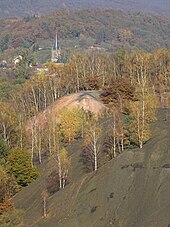You can help expand this article with text translated from the corresponding article in French. (October 2013) Click [show] for important translation instructions.
|


The Ronchamp Coal Mines were an area of coal mines located in the Vosges and Jura coal mining basins, in eastern France. They covered three municipalities; Ronchamp, Champagney and Magny-Danigon. Operated for more than two centuries, from the mid-eighteenth century until the mid-twentieth century, they have profoundly changed the landscape, the economy and the local population.
Mining began in Ronchamp in the mid-18th century and had developed into a large industry by the late 19th century, employing 1500 people.
Extraction started in adit before being dug at coal mine Saint Louis in 1810, introducing the first real extraction mine-shaft. The shaft seams sunk more and more, and became deeper until the well, owned by (Civil Society coal Ronchamp), eventually became the deepest mine in France beating the coal mine du Magny (694 meters) in 1878 and the coal mine Arthur de Buyer (1010 meters) in 1900. After the nationalisation of mines in 1946, the shaft and the thermal power station was entrusted to Electricité de France.
After closing in 1958, the mining sites and infrastructures were demolished and workers had to convert to other professions. Later, a museum and two associations were created to preserve the memory of the mining heritage and several sites were redeveloped to become tourist attractions.
The museum looks back at the miner's work, their techniques, tools they used and their social life. A collection of miners lamps are also on display.[1][2]
- ^ "Ronchamp et son association les amis du musée de la mine de Ronchamp". Les Amis du Musée de la Mine. Retrieved 2023-10-22.
- ^ "Le bassin houiller de Ronchamp" [Ronchamp Coal Basin]. Les Amis du Musée de la Mine. Retrieved 2023-10-22.